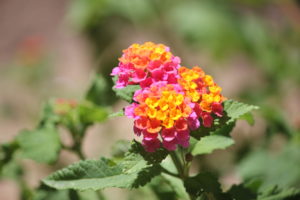
Rainbow Lantana (Lantana camara)
Abstract: The following research regards the effects of an invasive species, verbena (Lantana urticoides), on native plant species in a natural region at El Camino Baptist Church in Tucson, Arizona. The information was gathered from August to November of 2015. Data from the past 18 years on temperature, weather, human disturbances, patterns of succession, and native species’ abundances and densities in the study plot was utilized to determine what factors largely affect the increase or decline of the most abundant, native plants. In addition, the 15m x 15m area under study was gridded out to discover the locations and quantity of the invasive species, with the overall purpose of finding out, having taken into account numerous other factors, what native plants were most affected by the verbena in particular. The results revealed that horseweed (Conyza canadensis) seemed to have been most drastically affected by the invader. The rest of the native species which have been most abundant in past years appear to have been primarily affected by human disturbances instead, as is evident in the large numbers of species fluctuations revolving around the establishment of man-made soil barriers.
Key words: Invasive species, native species, abundance, Lantana urticoides, verbena, temperature, precipitation, human disturbance, patterns of succession
The Effects of Lantana urticoides on Native, Desert Plant Species in a Dense, Jungle-Like Region
Note: This paper is the work of both myself and three colleagues of mine, but their names have been removed from the report for the sake of privacy.